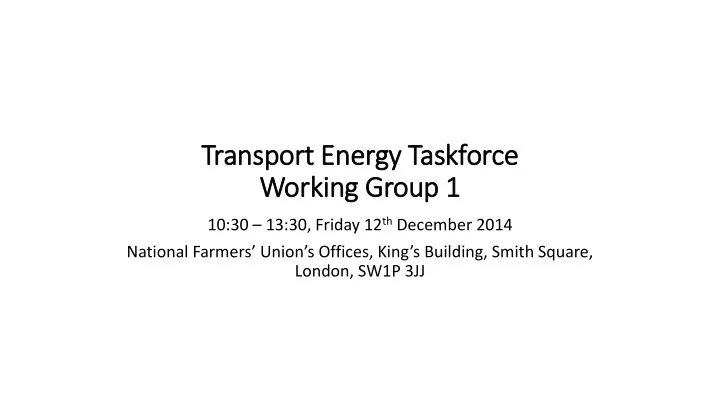

Transport Energy Taskforce Work rking Group 1 10:30 – 13:30, Friday 12 th December 2014 National Farmers’ Union’s Offices, King’s Building, Smith Square, London, SW1P 3JJ
Agenda 1. Introduction by chair 2. Minutes of modelling workshop and matters arising 3. Discussion of WG1 Terms of Reference 4. Presentation of 2030 transport fuel demand scenarios 5. 2020 scenarios modelling update 6. Presentation and discussion of initial 2030 biofuels options 7. Conclusion
3. Discussion of WG1 Terms of Reference 1. What are the key UK and EU road transport decarbonisation modelling excercises? What do they tell us? 2. What are the outcomes of the DfT modelling and key assumptions? How do they compare to other modelling excercises? 3. How can the UK modelling be improved? What will it mean? 4. What are the options for decarbonising road transport in the UK? What relative role can they play? 5. What do we need to believe in? What are the uncertainties? 6. What are possible decarbonisation trajectories 2020, 2030 and beyond? What do they imply? 7. What do the options / trajectories considered mean in terms of sustainability? What are the potential benefits to the UK? 8. What needs to happen for the options / trajectories to be realised?
4. . 2030 transport fuel demand scenarios
Projected transport energy consumption by fuel - high abatement scenario (carbon plan 2011) 60 50 tonnes of oil equivalent 40 30 20 10 -00 2010 2011 2012 2013 2014 2015 2016 2017 2018 2019 2020 2021 2022 2023 2024 2025 2026 2027 2028 2029 2030 Petrol - road Diesel - road Bioethanol - road Biodiesel - road Electricity - road Diesel - rail Electricity - rail Kerosene - aviation
Electric vehicle stock projections to 2030 14 12 50% 10 % new 40% Vehicle Millions of vehicles 8 Sales in 2030 6 20% 4 2 0 2014 2015 2016 2017 2018 2019 2020 2021 2022 2023 2024 2025 2026 2027 2028 2029 2030 low medium high
Bioenergy Strategy Scenario 1 optimal bioenergy allocation to 2050
Bioenergy Strategy Scenario 2 (no CCS) optimal bioenergy allocation to 2050
5. . 2020 Scenarios Modelling Update
2020 scenarios: 10% RED target with 0.5% advanced biofuel sub-target 4500 18 290 4000 3500 855 18 290 3000 43 Biomethane 18 High blend crop ethanol 290 Litres (millions) 855 2500 965 Advanced ethanol 18 290 Low blend crop ethanol 43 855 Advanced biodiesel 2000 336 High blend crop biodiesel 43 2 E8.6 E4.6 43 1132 E8.6 Low blend crop biodiesel E4.7 E8.6 1500 B10.2 B3.2 B7.4 B6.1 Low blend waste biodiesel B5.5 830 1519 1000 1760 112 1592 500 1012 746 506 0 RTFO year 6 supply low waste medium waste high waste high waste + forced E10 GHG Savings (MTCO2/yr) 4.7 MT 2.2 MT 3.1 MT 4.6 MT 1.8 MT Costs (£m/yr) £267m/year £264m/year £376m/year £283m/year £284m/year 1.18% Crop % 1.33% 0.46% 5.74% 3.59%
6. . In Initial 2030 Biofuels Options
Possible 2030 scenarios – 8% renewable energy target 4500 156 156 4000 156 156 156 156 347 347 3500 1068 1068 1774 1774 721 721 3000 Litres (millions) 2500 715 715 715 258 2000 1663 1206 1500 948 E10 and E20 0.5% sub-target 1000 1960 1960 1960 (zero crop) 500 1012 1012 1012 0 medium waste high waste medium waste high waste medium waste high waste E10 E20 0.5% advanced sub-target Low blend waste biodiesel Low blend crop biodiesel High blend crop biodiesel Advanced biodiesel Low blend crop ethanol Advanced ethanol High blend crop ethanol Biomethane GHG 3.2 5.4 7.7 8.5 7.9 8.3 Savings (MTCO2/yr) 143 292 248 -504 -186 -518 Costs (£m/yr) 0.5% 0.5% 3.1% 5.2% Advanced % 2.1% 6.2% 2.6% 0% 4.7% Crop % 0% 0% 0%
7. . Conclusion
What conclusions can be drawn from the modelling? • In all modelling scenarios considered there was a considerable volume of diesel, petrol and jet fuel in 2030 • Key known uncertainties include availability of waste fats and oils (first gen biodiesel); and costs and availability of advanced fuels • Forecast decreasing petrol demand leads to decreasing E5/10 bioethanol blending opportunities • The primary constraint to achieving 8% without crops appears to be advanced production capacity, esp for diesel, rather than feedstock availability.
Questions and Next Steps • Are there other modelling exercises we should consider? • Are all of the scenarios feasible in terms of production? • What should we assume for advanced costs? What other sources of data are available? • What should we assume for conventional biofuel costs? What other sources of data are available? • How can the modelling be improved? Are there other scenarios we should consider?
Source for E4tech and Element Energy slides • E4 tech data presented can be accessed through their website at http://www.e4tech.com/auto-fuel.html • Element energy data can be accessed at http://www.element- energy.co.uk/wordpress/wp-content/uploads/2014/06/Element- Energy-_-Fuels-roadmap_29May2014.pdf
Recommend
More recommend